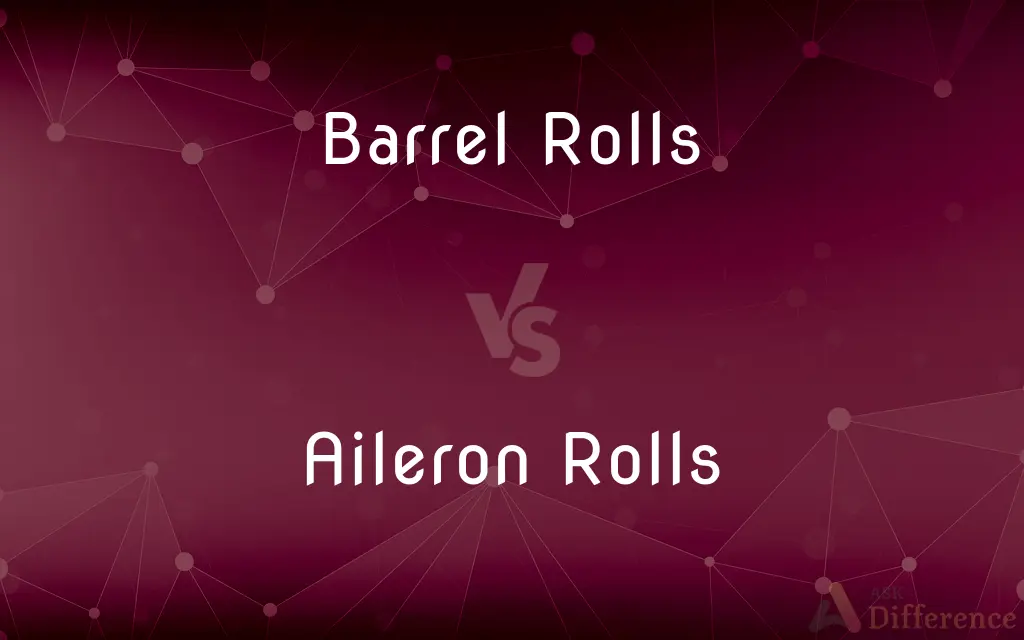Barrel Rolls vs. Aileron Rolls — What's the Difference?
By Tayyaba Rehman — Published on December 29, 2023
A Barrel Roll combines rolling and looping maneuvers with a helical path around a straight flight path, while an Aileron Roll is a 360° roll around the plane's longitudinal axis without change in altitude or direction.

Difference Between Barrel Rolls and Aileron Rolls
Table of Contents
ADVERTISEMENT
Key Differences
Barrel Rolls are aviation maneuvers in which an aircraft follows a helical path, reminiscent of a corkscrew, around a straight flight line. This means that while the plane is rolling, it's also looping. The name suggests the aircraft is flying as if it were moving around the surface of a barrel. On the other hand, Aileron Rolls are simpler in execution. An aircraft performing an Aileron Roll rotates around its longitudinal axis without significant change in altitude or direction.
The Aileron Roll gets its name from the use of the ailerons on an aircraft's wings to induce the roll. In this maneuver, the nose of the aircraft essentially stays in the same position and points in the same direction throughout the roll. Contrastingly, in Barrel Rolls, the nose of the plane describes a circular motion in the sky, and the aircraft does not maintain a constant altitude or direction.
When observing an aircraft perform a Barrel Roll, the flight path appears more complex. The aircraft seems to be weaving around a point in the sky, combining elements of both a loop and a roll. With Aileron Rolls, the motion is more straightforward, with the aircraft spinning on its axis, giving a pure rolling appearance without the added loop component.
In terms of complexity and skills required, a Barrel Roll is generally considered more challenging to perform than an Aileron Roll. This is because Barrel Rolls require the pilot to manage both pitch and roll simultaneously, ensuring a smooth helical path. Conversely, Aileron Rolls, while requiring skill and precision, primarily involve managing the roll.
Comparison Chart
Maneuver Description
Helical path around a straight flight line
360° roll around the plane's longitudinal axis
ADVERTISEMENT
Altitude & Direction
Changes in both during the maneuver
Remains consistent without significant change
Complexity
Combination of rolling and looping
Pure roll without looping
Control Used
Requires management of both pitch and roll
Primarily uses ailerons for roll
Origin of Name
Imagery of aircraft moving around a barrel's surface
From the use of ailerons on the wings to induce the roll
Compare with Definitions
Barrel Rolls
A flight maneuver where an aircraft follows a corkscrew path.
The pilot impressed the crowd with his precise Barrel Rolls.
Aileron Rolls
A rotation keeping the aircraft's nose in a consistent position.
The crowd appreciated the plane's stability during the Aileron Rolls.
Barrel Rolls
A challenging aerial stunt requiring skill and precision.
Novice pilots are advised to practice extensively before attempting Barrel Rolls.
Aileron Rolls
A pure roll without significant altitude or direction change.
Aileron Rolls are distinct with the nose pointing in the same direction throughout.
Barrel Rolls
A maneuver making the aircraft seem as if it's moving around a barrel.
The plane, during Barrel Rolls, seemed to dance around an invisible barrel in the sky.
Aileron Rolls
A maneuver using the ailerons to induce roll.
The pilot used the ailerons deftly to initiate the Aileron Rolls.
Barrel Rolls
A combination of rolling and looping in a single maneuver.
Barrel Rolls demand a pilot's attention to both the roll and loop aspects.
Aileron Rolls
A 360° roll around the aircraft's longitudinal axis.
The jet executed perfect Aileron Rolls in succession.
Barrel Rolls
A helical path around a straight flight direction.
Observers can trace the helical trajectory of Barrel Rolls from the ground.
Aileron Rolls
A straightforward aviation maneuver primarily managing the roll.
Beginners often start with Aileron Rolls before moving to more complex stunts.
Common Curiosities
Do Aileron Rolls change the plane's altitude?
No, Aileron Rolls are performed without significant altitude change.
Which maneuver primarily uses the ailerons?
Aileron Rolls primarily utilize the ailerons to induce the roll.
Which is more complex, Barrel Rolls or Aileron Rolls?
Barrel Rolls are generally considered more complex due to the combination of rolling and looping.
How does the aircraft's nose move during Aileron Rolls?
In Aileron Rolls, the aircraft's nose stays in the same position and direction.
Can Barrel Rolls be performed by all aircraft?
Not all aircraft are designed or capable of safely performing Barrel Rolls.
Is it true Aileron Rolls don't change direction?
Yes, during Aileron Rolls, the aircraft's direction remains consistent.
Why are Barrel Rolls named so?
They're named after the imagery of a plane moving around a barrel's surface.
How can one visually differentiate between the two rolls from the ground?
Barrel Rolls have a helical path with altitude changes, while Aileron Rolls show a pure rotation around the plane's axis.
Do pilots require special training for Aileron Rolls?
While all aerial maneuvers need training, Aileron Rolls are among the basic stunts taught.
Which roll doesn't change the plane's direction?
Aileron Rolls keep the plane's direction consistent throughout.
Which roll combines elements of both loop and roll?
Barrel Rolls combine elements of both loop and roll.
Is it common for airshows to feature Barrel Rolls?
Yes, Barrel Rolls, due to their complexity, are often showcased in airshows.
Are Aileron Rolls safe for novice pilots?
While safer than some stunts, any aerial maneuver requires training and understanding of the aircraft.
Do Barrel Rolls demand simultaneous pitch and roll management?
Yes, Barrel Rolls require managing both pitch and roll simultaneously.
Share Your Discovery

Previous Comparison
Te Spanish vs. Tu Spanish
Next Comparison
ADR vs. GDRAuthor Spotlight
Written by
Tayyaba RehmanTayyaba Rehman is a distinguished writer, currently serving as a primary contributor to askdifference.com. As a researcher in semantics and etymology, Tayyaba's passion for the complexity of languages and their distinctions has found a perfect home on the platform. Tayyaba delves into the intricacies of language, distinguishing between commonly confused words and phrases, thereby providing clarity for readers worldwide.











































